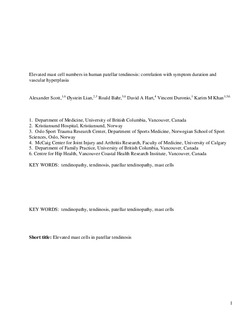| dc.contributor.author | Scott, Alexander | |
| dc.contributor.author | Lian, Øystein | |
| dc.contributor.author | Bahr, Roald | |
| dc.contributor.author | Hart, David A. | |
| dc.contributor.author | Duronio, Vincent | |
| dc.contributor.author | Khan, Karim M. | |
| dc.date.accessioned | 2009-04-06T10:26:35Z | |
| dc.date.issued | 2008-02-28 | |
| dc.identifier | Seksjon for idrettsmedisinske fag / Department of Sports Medicine | |
| dc.identifier.citation | British Journal of Sports Medicine. 2008, 42(9), 753-757 | en |
| dc.identifier.issn | 0306-3674 | |
| dc.identifier.uri | http://hdl.handle.net/11250/170833 | |
| dc.description | I Brage finner du siste tekst-versjon av artikkelen, og den kan inneholde ubetydelige forskjeller fra forlagets pdf-versjon. Forlagets pdf-versjon finner du på http://dx.doi.org/doi:10.1136/bjsm.2007.040212 / In Brage you'll find the final text version of the article, and it may contain insignificant differences from the journal's pdf version. This article has been accepted for publication in BJSM following peer review. The definitive copyedited, typeset version is available online at http://dx.doi.org/doi:10.1136/bjsm.2007.040212 | en |
| dc.description.abstract | Objectives: The cellular basis of painful tendon overuse pathology (tendinosis) is poorly understood. It has been suggested that because of the close anatomical associations between mast cells and vessels in connective tissues, mast cells may mediate the development of tendon hypervascularity or oedema.
Objectives: To examine the distribution of mast cells in men and women with patellar tendinopathy.
Design: Case–control study.
Methods: Tendinopathic tissue was collected at open debridement of the patellar tendon and a control tendon from patients undergoing intramedullary nailing of the tibia. The tendon was assessed immunohistochemically by evaluating the distribution of mast cells (AA1), and markers for T lymphocytes (CD3) and macrophages (CD68). The vessel-area fraction was quantified using computer-assisted digital image analysis.
Results: The prevalence of mast cells per mm2 (mean 3.3 (SD 3.0)) was greater in tendinosis tissue than in controls (1.1 (1.5); p = 0.036). In patients with tendinosis, mast cell density was moderately correlated with the vessel-area fraction (r2 = 0.49) and with symptom duration (r2 = 0.52).
Conclusion: Mast-cell prevalence in patellar tendinopathy was increased and was predominantly associated with vascular hyperplasia, particularly in patients with longstanding symptoms. Future research should investigate whether mast cells play direct or indirect modulatory roles in the development and progression of human tendinosis. | en |
| dc.format.extent | 46608 bytes | |
| dc.format.mimetype | application/pdf | |
| dc.language.iso | eng | en |
| dc.publisher | BMJ Publishing Group Ltd | en |
| dc.subject | adult | en |
| dc.subject | biopsy, needle | en |
| dc.subject | blood vessels | en |
| dc.subject | case-control studies | en |
| dc.subject | cell count | en |
| dc.subject | female | en |
| dc.subject | humans | en |
| dc.subject | hyperplasia | en |
| dc.subject | immunohistochemistry | en |
| dc.subject | inflammation | en |
| dc.subject | male | en |
| dc.subject | mast cells | en |
| dc.subject | patellar ligament | en |
| dc.subject | tendinopathy | en |
| dc.subject | methods | en_US |
| dc.subject | pathology | en_US |
| dc.title | Increased mast cell numbers in human patellar tendinosis: correlation with symptom duration and vascular hyperplasia | en |
| dc.type | Peer reviewed | en |
| dc.type | Journal article | en |
| dc.subject.nsi | VDP::Social science:200::Social science in sports:330::Other subjects within physical education:339 | |
| dc.source.pagenumber | 753-757 | en |
| dc.source.volume | 42 | en |
| dc.source.journal | British Journal of Sports Medicine | en |
| dc.source.issue | 9 | en |
